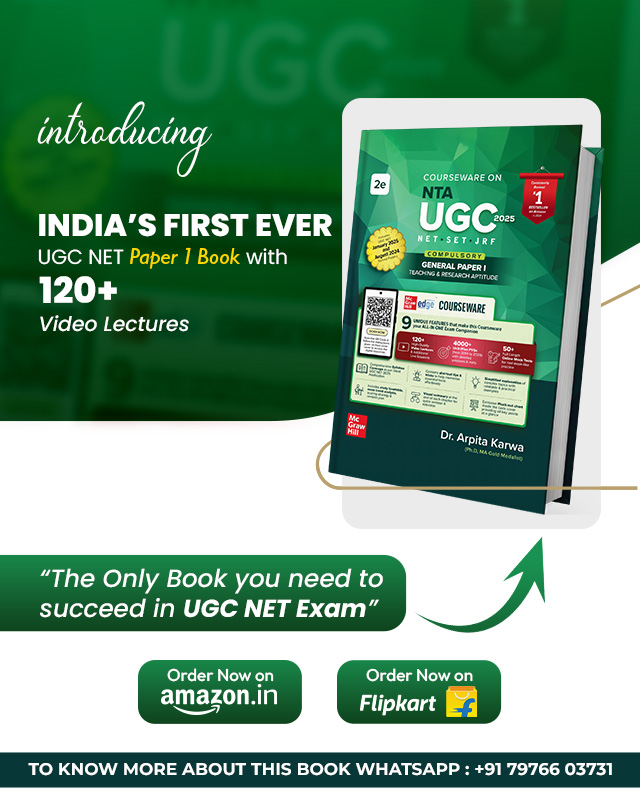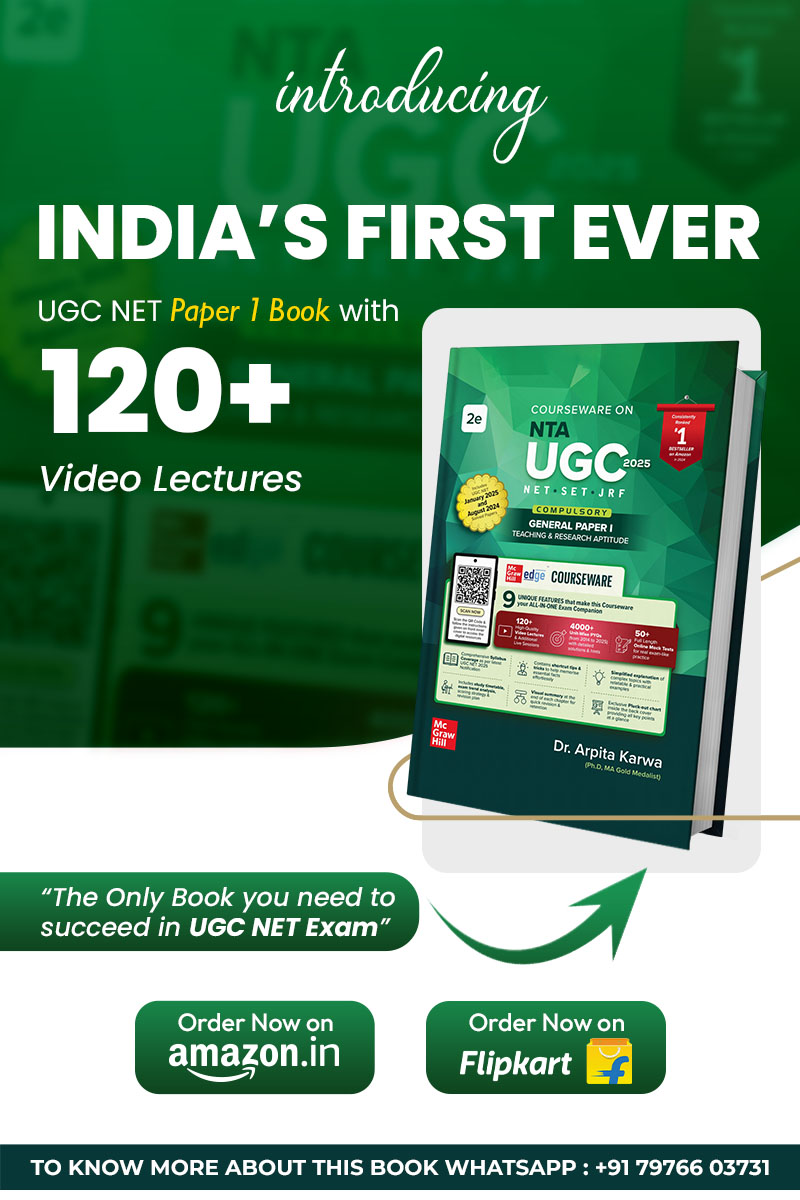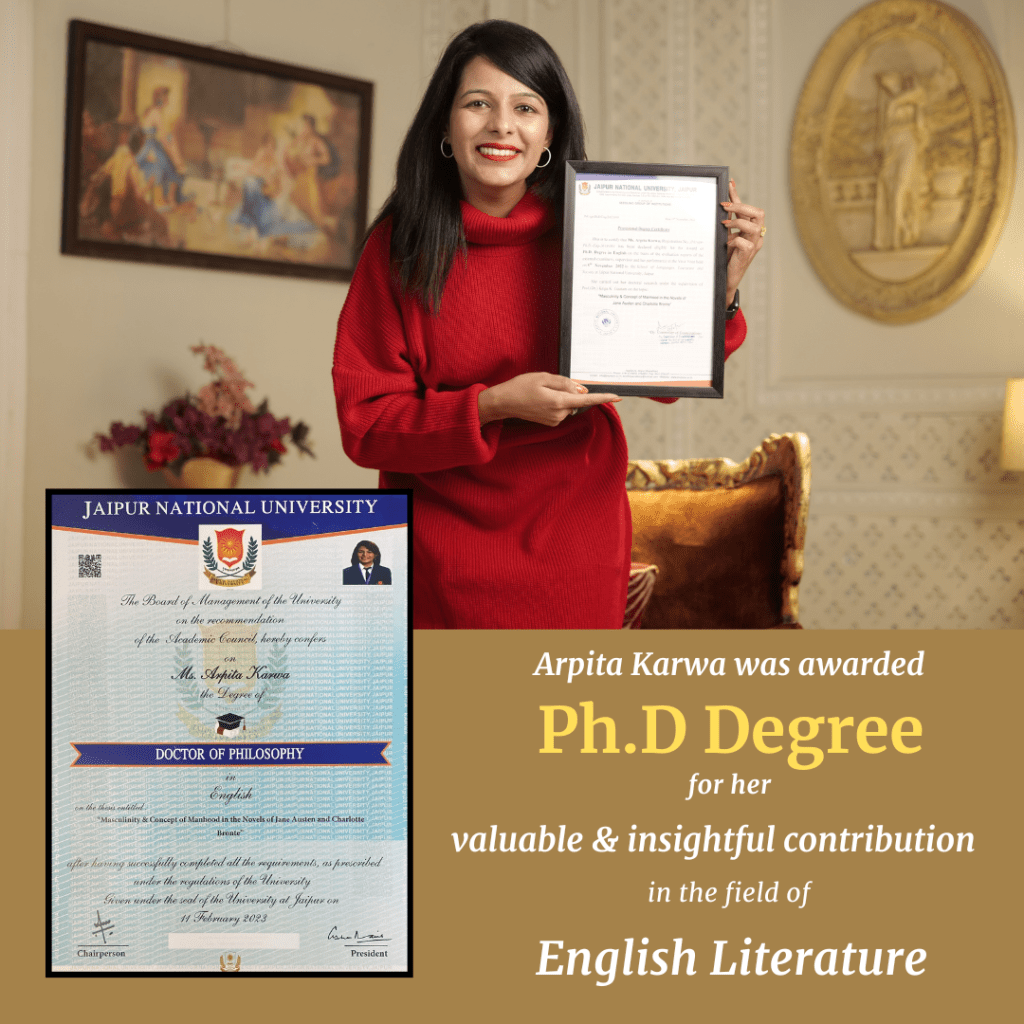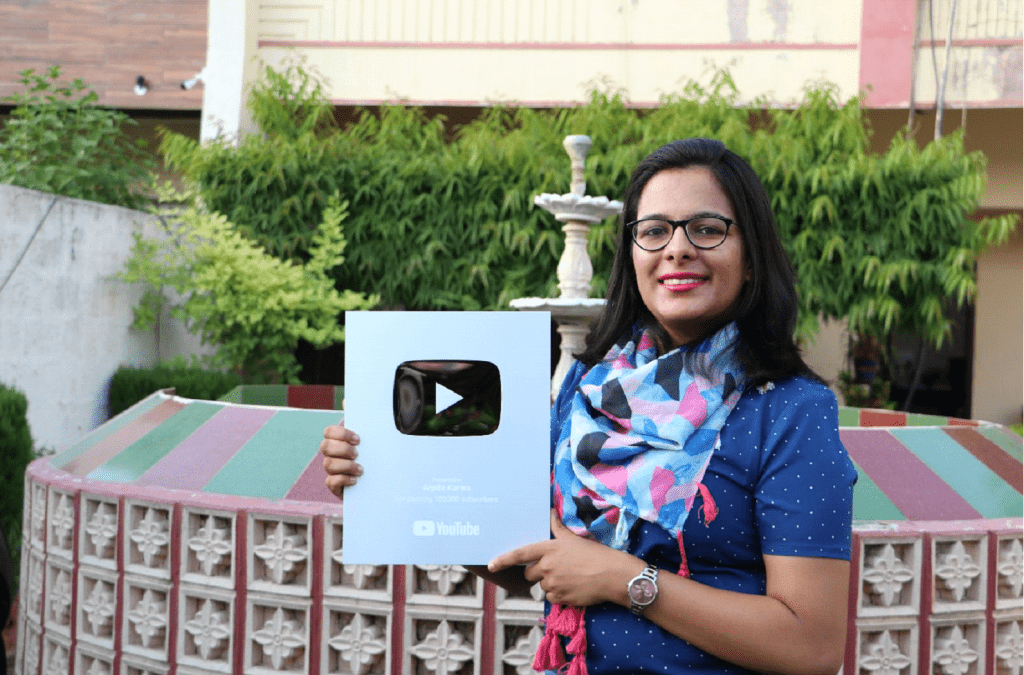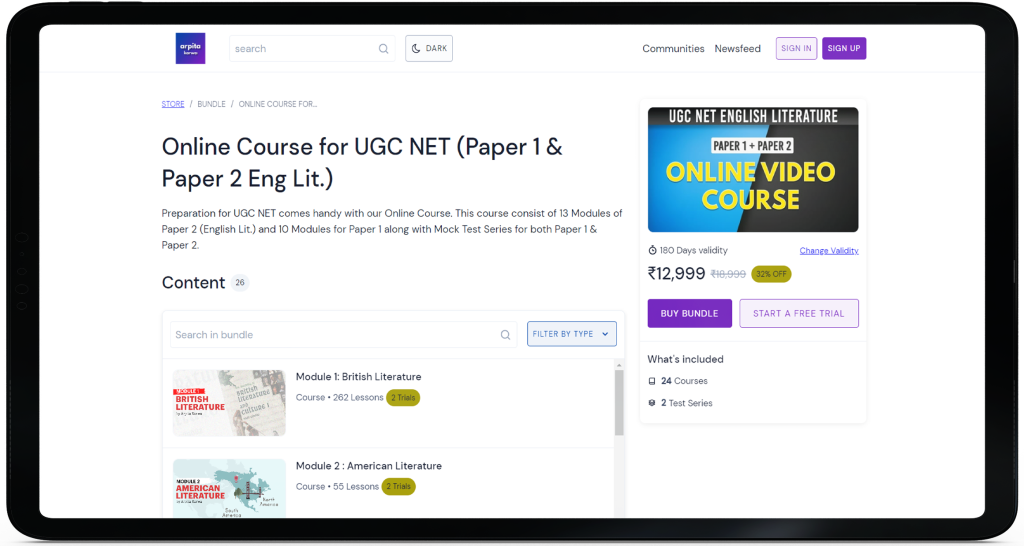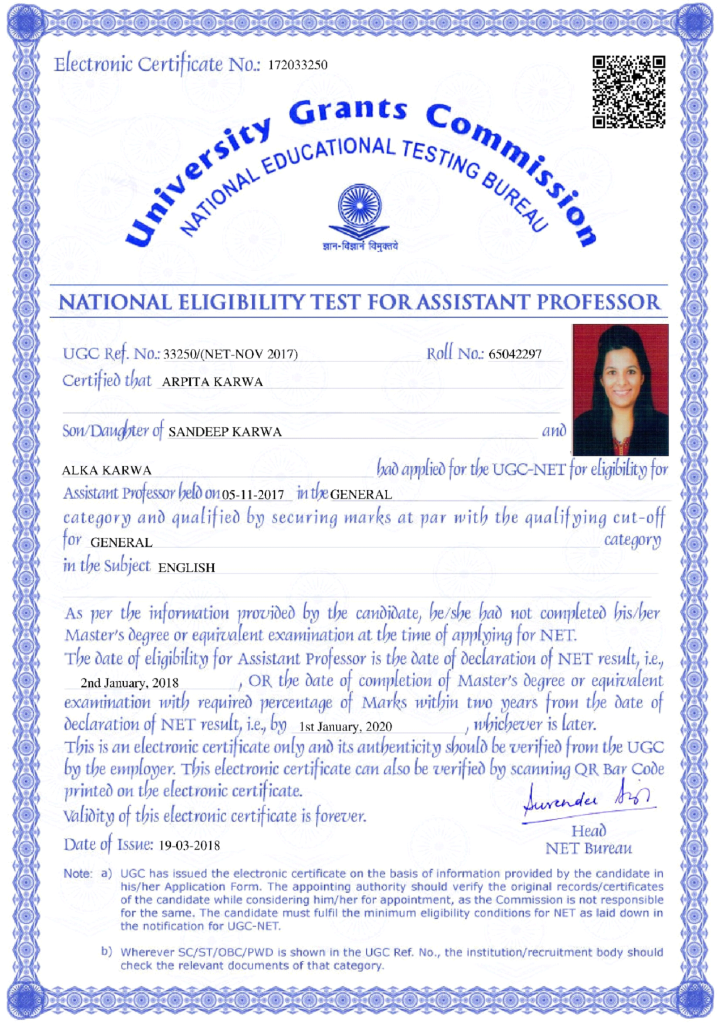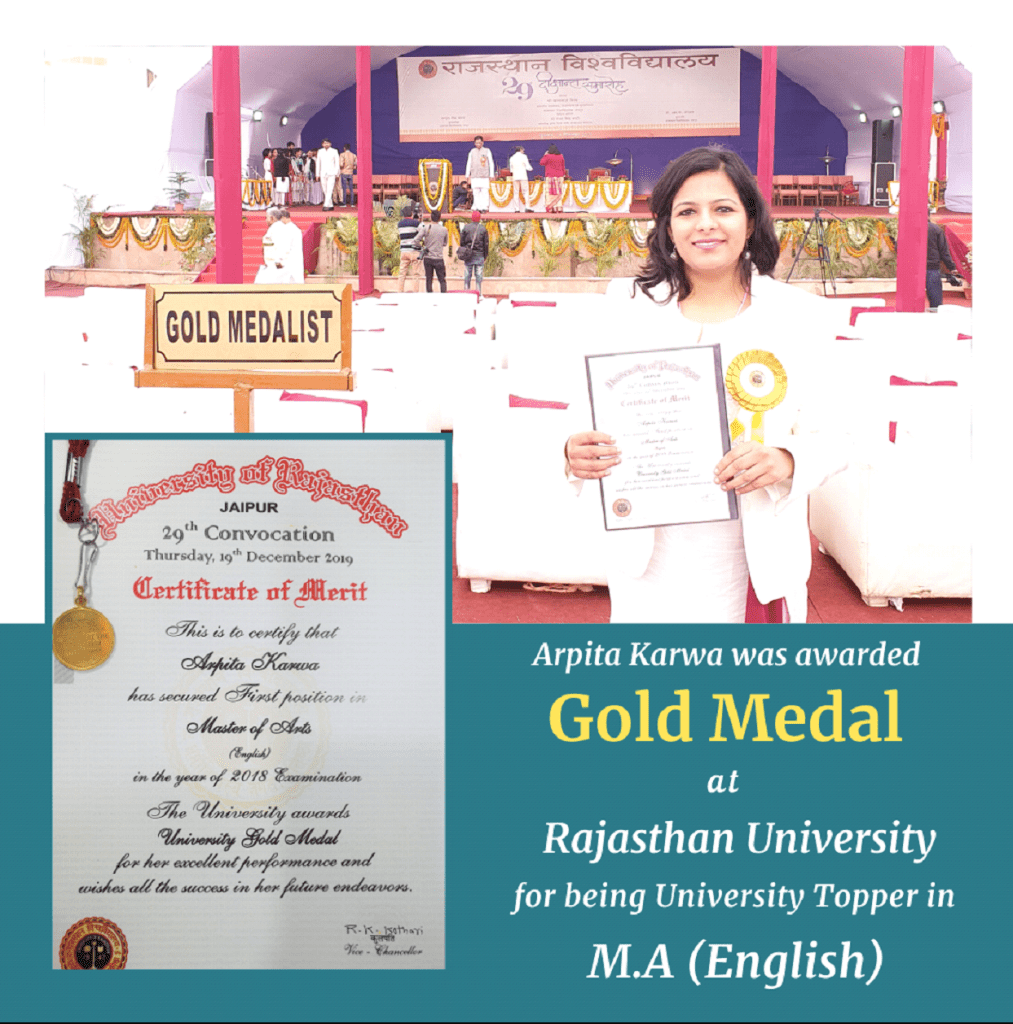JNU M.A. ENGLISH, ENTRANCE EXAM 2021
June 19, 2023 2023-12-11 18:25JNU M.A. ENGLISH, ENTRANCE EXAM 2021
JNU M.A. English, Entrance Exam 2021
JNU
M.A. ENGLISH ENTRANCE EXAM, 2021
Q.1) Michael Ondaatje’s novel that has the North African/ Italian Campaigns of World War as its historical backdrop:
[1] The English Patient (1992)
[2] In the Skin of a Lion (1987)
[3] Coming Through Slaughter (1976)
[4] Divisadero (2007)
Answer: The English Patient (1992)
Q.2) According to Aristotle, which is/are the essential element(s) of a ‘complex tragic plot’?
[1] Ethos & Dianoia
[2] Peripeteia &Anagnorisis
[3] Hamartia
[4] Catharsis & Mimesis
Answer: Peripeteia &Anagnorisis
Q.3) The critical treatise The Dialogic Imagination (1975) was written by:
[1] Northrop Frye
[2] Roman Jakobson
[3] Mikhail M. Bakhtin
[4] Jan Mukarovsky
Answer: Mikhail M. Bakhtin
Q.4) Who coined the term ‘New Criticism’?
[1] Cleanth Brooks
[2] Allen Tate
[3] Monroe C. Beardsley
[4] John Crowe Ransom
Answer: John Crowe Ransom
Q.5) Choose the correct sequence of the following schools of criticism theory:
[1]Structuralism, Deconstruction, Reader-Response theory, New Historicism
[2]Deconstruction, Reader-Response theory, New Historicism, Structuralism
[3]Reader-Response theory, Structuralism, Deconstruction, New Historicism
[4] New Historicism, Structuralism, Reader-Response theory, Deconstruction
Answer: Structuralism, Deconstruction, Reader-Response theory, New Historicism
Q.6) Aristotle’s “law of probability and necessity” refers to which element of tragedy?
[1] Ethos
[2] Melos
[3] Opsis
[4] Mythos
Answer: Mythos
Q.7) According to Longinus, which two conditions of sublimity depend mainly on ‘natural genius’?
[1] Majesty and elevation of structure, and Dignified expression.
[2] Dignified expression, and A certain artifice in the employment of figures.
[3] Grandeur of thought, and A vigorous and spirited treatment of the passions.
[4] Majesty and elevation of structure, and Grandeur of thought.
Answer: Grandeur of thought, and A vigorous and spirited treatment of the passions
Directions (Qs. No. 8-12): Read the following passage carefully, and select the right answersfrom the alternatives given below in the questions that follow:
One can sum up modern poetic technique by calling it the rediscovery of metaphor and the full commitment to metaphor. The poet can legitimately step out into the universal only by first going through the narrow door of the particular. The poet does not select an abstract theme and then embellish it with concrete details. On the contrary, he must establish the details, must abide by the details, and through his realization of the details attain to whatever general meaning he can attain. The meaning must issue from the particulars; it must not seem to be arbitrarily forced upon the particulars. Thus, our conventional habits of language have to be reversed when we come to deal with poetry. For here it is the tail that wags the dog. Better still, here it is the tail of the kite – the tail that makes the kite fly – the tail that renders the kite more than a frame of paper blown crazily down the win
[4] The tail of the kite, it is true, seems to negate the kite’s function: it weights down something made to rise; and in the same way, the concrete particulars with which the poet loads himself seem to deny the universal to which he aspires. The poet wants to “say” something. Why, then, doesn’t he say it directly and forthrightly? Why is he willing to say it only through his metaphors? Through his metaphors, he risks saying it partially and obscurely, and risks not saying it at all. But the risk must be taken, for direct statement leads to abstraction and threatens to take us out of poetry altogether.
Q.8) The writer thinks that the conventional habits of language are reversed in poetic expression. It is so. because poetic expressions are ……………
[1] Ironical
[2] Linguistic
[3] Cultural
[4] Emotional
Answer: Ironical
Q.9) What does the writer claim about the modern poetic technique?
[1] It’s about re-using the old metaphors.
[2] It’s about inventing new poetic metaphors.
[3] It’s about the metaphorical essence of poetic expression.
[4] None of the above.
Answer: It’s about the metaphorical essence of poetic expression
Q.10) What does the writer convey through the analogies of kite and dog?
[1] That poetry has grounds of equivalence with the kite and the dog.
[2] That poetry functions like a kite and a dog.
[3] The analogies imply a principle of indirection as the essence of poetic structure.
[4] None of the above.
Answer: The analogies imply a principle of indirection as the essence of poetic structure
Q.11) The poet does not select an abstract theme because ………….. .
[1] The poetic structure organically generates meaning.
[2] The poet wants to separate form and meaning.
[3] Poetry deals only with particular and specific meaning.
[4] None of the above.
Answer: The poetic structure organically generates meaning
Q.12) What does the statement “The poet can legitimately step out into the universal only by first going through the narrow door of the particular” imply?
[1] The poet expresses universally accepted meaning
[2] The poet expresses particular meaning.
[3] The poet focuses only on the minute particularities of the poem.
[4] None of the above.
Answer: The poet focuses only on the minute particularities of the poem
Q.13) Which of the following writers belong to the Maori tradition of writing?
(a) Patricia Grace
(b) Witi Ihimaera
(c) Helen Dale
(d) Keri Hulme
Codes:
[1] (a), (b) and (d) only
[2] (b), (c) and (d) only
[3] (a), (b) and (c) only
[4] (a), (b) and (d) only
Answer: (a), (b) and (d) only
Q.14) Dr. Samuel Johnson observed the rules of French rhetorical tragedy in:
[1] Irene
[2] London
[3] The Vanity of Human Wishes
[4] The Lives of Poets
Answer: Irene
Q.15) Spanish American poet Vicente Huidobro in his doctrine, Creacionismo, evolved from his 1914 manifesto, Non serviam declares:
[1] Art should not imitate reality but create it.
[2] Art while imitating creates the reality.
[3] Art and reality are reciprocal.
[4] Reality is local; art is global.
Answer: Art should not imitate reality but create it
Q.16) “To one who said that myths were lies and therefore worthless, even though ‘breathed through silver'”. This line from a poem by J. R. R. Tolkien is addressed to:
[1] J. K. Rowling
[2] C. S. Lewis
[3] William Blake
[4] George Macdonald
Answer: C. S. Lewis
Q.17) Which one of the following options is a major theme of P.B. Shelley’s “Ozymandias?”
[1] Nature of Power
[2] Power of Nature
[3] Love for Nature
[4] Human Suffering
Answer: Nature of Power
Q.18) In the Preface of Karukku (1992), Bama refers to a citaton from the New Testament in which the word of God is described as a two-edged swor
[4] Which Book of New Testament does she refer to?
[1] Epistle to the Laodicians
[2] Epistle to the Corinthians
[3] Epistle to the Alexandrians
[4] Epistle to the Hebrews
Answer: Epistle to the Hebrews
Q.19) Match List-I with List-II:
List-I
(a) Ravenna
(b) The Decay of Lying
(c) The Selfish Giant
(d) An Ideal Husband
List-II
(i) Play
z(ii) Essay
(iii) Short Story
(iv) Poem
Choose the correct answer from the options given below:
[1] a-iv, b-i, c-iii, d-ii
[2] a-i, b-iii, c-ii, d-iv
[3] a-iv, b-ii, c-iii, d-i
[4] a-iii, b-i, c-iv, d-ii
Answer: a-iv, b-ii, c-iii, d-i
Q.20) Who coined the term ecriture feminine?
[1] Judith Butler
[2] Helene Cixous
[3] Julia Kristeva
[4] Luce Irigaray
Answer: Helene Cixous
Q.21) Read the pair of works and authors carefully to answer the question that follows:
(a) Triple Dictionarie – John Baret
(b) A Dictionarie French and English – Thomas Wilson
(c) A ChristainDictionarie – Claudius Holyband
Codes:
[1] (a) is correct and (b) and (c) are incorrect
[2] (b) is correct and (a) and (c) are incorrect
[3] (b) and (c) are Correct (a) is incorrect
[4] All are incorrect
Answer: (a) is correct and (b) and (c) are incorrect
Q.22) Match List-I with List-II:
List-I
Play
(a) Don’s Party (1971)
(b) The Cake Man (1975)
(c) The Season at Sarsaparilla (1962)
(d) Barungin (1989)
List II
Author
(i) Robert Merritt
(ii) Jack Davis
(iii) David Williamson
(iv) Dorothy Hewett
(v) Patrick White
Choose the correct answer from the options given below:
[1] a-v, b-iv, c-iii, d-ii
[2] a-iii, b-i, c-v, d-ii
[3] a-i, b-iii, c-v, d-ii
[4] a-iv, b-ii, c-iii, d-i
Answer: a-iii, b-i, c-v, d-ii
Q.23) Match List-I with List-II:
List-I
(a) The Examiner
(b) The Critical Review
(c) The Annual register
(d) The Bee
List-II
(i) Leigh Hunt
(ii) Edmund Burke
(iii) Tobias Smollett
(v) Oliver Goldsmith
[1] a-iv, b-i, c-iii, d-ii
[2] a-i, b-iii, c-ii, d-iv
[3] a-iv, b-iii, c-i, d-ii
[4] a-iii, b-i, c-iv, d-ii
Answer: a-i, b-iii, c-ii, d-iv
Q.24) What is the historical sequence of the following Indian literary theorists/philosophers of language?
(a) Bharata
(b) Panini
(c) Bhartrhari
(d) Abhinavagupta
Choose the correct answer from the options given below:
[1] (a), (b), (c), (d)
[2] (a), (c), (b), (d)
[3] (b), (a), (c), (d)
[4] (c), (b), (a), (d)
Answer: (b), (a), (c), (d)
Q.25) Which Cultural Theorist has signified nation-state as a “vertebrate structure”?
[1] Arjun Appadurai
[2] Raymond Williams
[3] Terry Eagleton
[4] Fredric Jameson
Answer: Arjun Appadurai
Q.26) Which of the following novels may be placed in the Cli-Fi genre:
(a) Odds Against Tomorrow (2013)
(b) Shatnerquake (2009)
(c) Oryx and Crake (2003)
(d) War Girls (2019)
(e) Gold Fame Citrus (2015)
Choose the correct answer from options given below:
[1] (a), (b) and (d) only
[2] (a), (c), (d) and (e) only
[3] (a), (b), (c) and (d) only
[4] (a), (c) and (d) only
Answer: (a), (c), (d) and (e) only
Q.27) Match List-I with List-II:
List-I
(a) Dactylic
(b) Iambic
(c) Trochaic
(d) Amphibrachic
List-II
(i) an accented syllable is followed by an unaccented one
(ii) an unaccented syllable is followed by an accented one.
(iii) an accented syllable is followed by two unaccented sallables
(iv) Middle syllable is accented, while the first and the third syllable are unaccented
Codes:
[1] a-iv, b-i, c-iii, d-ii
[2] a-i, b-ii, c-iii, d-iv
[3] a-iv, b-iii, c-i, d-ii
*[4] a-iii, b-ii, c-i, d-iv
Answer: a-iii, b-ii, c-i, d-iv
Q.28) Match List-I with List-II:
List-I
(a) Jose Marti
(b) Eugenio Maria de Hostos
(c) Ruben Dario DI Nicaragua
(d) Jose Santos Chocano
List-II
(i) Cuba
(ii) Peru
(iii) Nicaragua
(iv) Puerto Rico
Choose the correct answer from the options given below:
[1] a-iv, b-i, c-iii, d-ii
[2]a-i, b-iv, c-iii, d-ii
[3]a-iv, b-iii, c-i, d-ii
[4]a-iv, b-ii, c-iii, d-i
Answer: a-i, b-iv, c-iii, d-ii
Q.29) Choose the essential characteristics of the Dime novel:
(a) The Dime novel was a magazine sized pamphlet publication of tightly packed print that featured a single story.
(b) The Dime novel was a magazine sized pamphlet publication of tightly packed print that featured multiple stories.
(c) It primarily narrated adventure stories.
(d) This story was published on inexpensive pulpwood paper with a cover illustration and sold for a nickel or a dime.
(e) It was popular in America in late 19th and early 20th centuries.
Codes:
[1] (a), (b), (c) and (d) only
[2] (a), (c), (d) and (e) only
[3] (b), (c), (d) and (e) only
[4] (a), (b) and (d) only
Answer: (a), (c), (d) and (e) only
Q.30) Gilles Deleuze and Felix Guattari have extensively used the concept of ‘Body without Organs’ in their philosophical works.
The term has its origin in:
[1] Ernst Kantorowicz’s The King’s Two Bodies (1957)
[2] Judith Butler’s Bodies that Matter (1993)
[3] Antonin Artaud’s To Have Done with the Judgment of God (1947)
[4] Georges Bataille’s Story of the Eye (1928)
Answer: Antonin Artaud’s To Have Done with the Judgment of God (1947)
Q.31) “In cultural studies, ethnography is not a means to verify the “true” meaning or meanings of a “text”; rather, ethnographic investigation is undertaken as a means to discover the meanings people make, the meanings which circulate and become embedded in the lived cultures of people’s everyday lives.” Which prominent theorist of Popular Culture has written these lines?
[1] Benjamin K. Urish
[2] John Storey
[3] Ray B. Browne
[4] Rosemary Levy Zumwalt
Answer: John Storey
Q.32) Swinburne’s “Songs before Sunrise” (1871) represents:
[1] Symbol of new religion of resurrection and love
[2] Liberty and independence in Europe
[3] Mysteries and vitality of Nature
[4] Celebration of Darwinian theory of evolution into a pantheistic feeling
Answer: Liberty and independence in Europe
Q.33) Match List-I with List-II:
List-I
(English Traslation)
(a) Kalikatha : Via Bypass (2002)
(b) Samskara : A Rite for a Dead Man (1976)
(c) MailaAnchal : Soiled Border (1991)
(d) Indulekha (2005)
List-II
Translator
(i) Indira Jungharee
(ii) Alka Saraogi
(iii) AnithaDevasia
(iv) A. K. Ramanujan
(v) Gillian Wright
(The year mentioned after the title of the novel refers to the publication year of translation)
Choose the correct answer from the options below:
[1] a-ii, b-iv, c-i, d-iii
[2] a-ii, b-i, c-iv, d-v
[3] a-ii, b-iv, c-v, d-iii
[4] a-ii, b-iv, c-iii, d-v
Answer: a-ii, b-iv, c-i, d-iii
Q.34) Match List-I with List-II:
List-I
(a) Induction
(b) The Glass of Government
(c) A Newe Interlude of Vice
(d) Damon and Pythias
List-II
(i) Thomas Sackville
(ii) George Gascoigne
(iii) John Pickeryngs
(iv) Richard Edwarden
Choose the correct answer from the optiongiven below:
[1] a-iv, b-i, c-iii, d-ii
[2] a-i, b-ii, c-iii, d-iv
[3] a-iv, b-iii, c-i, d-ii
[4] a-iii, b-i, c-iv, d-ii
Answer: a-i, b-ii, c-iii, d-iv
Q.35) Given below are two statements, one is labelled as Assertion (A) and the other is labelled as Reason (R):
Assertion (A): Bernard Mandeville’s The Fable of the Bees (1714) argues that corruption is an integral part of a nation becoming rich and powerful.
Reason (R) : A mercantile country survives on sharp practice and theft.
In light of the above statements, choose the correct answer from the options given below:
[1] Both (A) and (R) are True
[2] Both (A) and (R) are false
[3] (A) is true but (R) is false
[4] (A) is false but (R) is true
Answer: Both (A) and (R) are True
Q.36) Which of the following texts has NOT been written by Eugene Nida?
[1] Towards a Science of Translating (1964)
[2] Contexts in Translating (2002)
[3] From One Language to Another (1986)
[4] Translation as Recovery (2004)
Answer: Translation as Recovery (2004)
Q.37) Which of the following have been defined as ,powers b or ‘functions’ of the word or the sentence by Abhinavagupta in his work Locana:
(a) abhidha
(b) laksana
(d) tatparya
(e) dhvani
Choose the correct answer from the options given below:
[1] (a), (b), (c) and (d) only
[2] (b), (c), (d) and (e) only
[3] (a), (c), (d) and (e) only
[4] (a), (b), (d) and (e) only
Answer: (a), (b), (d) and (e) only
Q.38) A Christmas Carol (1844) by Charles Dickens is:
[1] Novel
[2] Short Story
[3] Novella
[4] Christmas Song
Answer: Novella
Q.39) Which among the following is thought to be the first text written in the spirit of secular morality?
[1] Wyt and Science
[2] Magnyfycence
[3] The Four Elements
[4] Satyre of the Three Estatis
Answer: Magnyfycence
Q.40) Tim Luke’s Eco critique (1997) adapts:
[1] T.S. Eliot’s The Wasteland into that of a “Greenland”.
[2] Michel Foucault’s concept of “governmentality” into that of “environmentality”.
[3] Derrida’s concept of “difference” into that of “sustainability”
[4] Homi Bhabha’s concept of “third space” into that of “human space.”
Answer: Michel Foucault’s concept of “governmentality” into that of “environmentality”.
Q.41) Reliques of Ancient English Poetry (1765) authored by:
[1] Thomas Percy
[2] Thomas Chatterton
[3] Richard Hurd
[4] Thomas Tyrwhitt
Answer: Thomas Percy
Q.42) Which among the following is incorrect? –
[1] Anacrusis – Where there is an extra unaccented syllable at the beginning of each of the verse except the first.
[2] Synaeresis – Where there is a coalescence of short and unaccented vowels.
[3] Elision – Where an extra syllable is used in the verse to complete.
[4] Hypermetrical – Where the verses terminate in unaccented syllables.
Answer: Elision – Where an extra syllable is used in the verse to complete
Q.43) Auteur Theory is a critical model used in:
[1] Existentialism
[2] Renaissance art
[3] Film Studies
[4] Theatre of Cruelty
Answer: Film Studies
Q.44) Who among the following is not associated with The Oxford Movement?
[1] John Henry Newman
[2] John Keble
[3] William Holeman Hunt
[4] Robert Wilberforce
Answer: William Holeman Hunt
Q.45) Thea Astley’s The Acolyte (1972) was written partly
[1] Jessica Anderson’s The Last Man’s Head (1970) in response to:
[2] Xavier Herbert’s Soldiers’ Women (1961)
[3] Patrick White’s The Vivisector (1970)
[4] Barry Oakley’s A Salute to the Great McCarthy (1970)
Answer: Patrick White’s The Vivisector (1970)
Q.46) The ‘Big Four’ of the Great Boom of Latin American Fiction includes Gabriel Garcia Marquez, Vargas Llosa, Julio Cortazar and:
[1] Lezama Lima
[2] Cabrera Infante
[3] Jose Manuel Donoso
[4] Carlos Fuentes
Answer: Carlos Fuentes
Q.47) Given below are two statements, one is labelled as Assertion (A) and the other is labelled as Reason (R):
Assertion (A):In his book The Signifying Monkey (1988), Henry Louis Gates Jr. assigns importance to vernacular in identifying a particularly African American tradition of literary theory.
Reason (R): Gates argues that African Americans are signified as monkeys by whites; therefore, they have to look for their own sign language.
In light of the above statements, choose the correct answer from the options given below:
[1] Both (A) and (R) are true and (R) is the correct explanation of (A)
[2] Both (A) and (R) are true correct explanation of (A)
[3] (A) is true but (R) is false
[4] (A) is false but (R) is true
Answer: (A) is true but (R) is false
Directions (Qs. No. 48-52): Read the following poem carefully, and select the correct answer from the alternatives given below in the questions that follow:
“A City’s Death by Fire” Derek Walcott After that hot go speller has levelled all but the churched sky, I wrote the tale by tallow of a city’s death by fire; Under a candle’s eye, that smoked in tears, I Wanted to tell, in more than wax, of faiths that were snapped like wire. All day I walked abroad among the rubbled tales, liar; Shocked at each wall that stood on the street like a bales Loud was the bird-rocked sky, and all the clouds were Torn open by looting, and white, in spite of the fire. By the smoking sea, where Christ walked, I asked, why Should a man wax tears, when his wooden world fails? In town, leaves were paper, but the hills were a flock of faiths; To a boy who walked all day, each leaf was a green breath Rebuilding a love I thought was dead as nails, Blessing the death and the baptism by fire.
Q.48) The expression, “each leaf was a green breath” is a:
[1] metaphor
[2] zeugma
[3] simile
[4] anti-climax
Answer: metaphor
Q.49) What figure of speech is denoted by the title of the poem “A City’s Death by Fire?”
[1] Metonymy
[2] Synecdoche
[3] Metaphor
[4] Personification
Answer: Personification
Q.50) By the expression, “of faiths that were snapped like wires,” the poet means:
[1] the poet’s loss of faith in the God.
[2] the poet’s loss of faith in humanity.
[3] the poet’s loss of faith in the smugness of the human kind.
[4] the poet’s loss of faith in the local church.
Answer: the poet’s loss of faith in the smugness of the human kind
Q.51) Which among the following best expresses the theme of the poem?
[1] The city engulfed by fire and speaker’s faith in God.
[2] The city fire that reached the hill and destroyed the speaker’s faith in the Church.
[3] Colonial destruction of the city by fire.
[4] Walking through the burning city.
Answer: The city engulfed by fire and speaker’s faith in God
Q.52) By the line “Under a candle’s eye, that smoked in tears, I wanted to tell….” the poet suggests:
[1] the composition of the poem in a room without electricity.
[2] the sorrow of the people of the city due to the fire that moved him to write the poem under a candle.
[3] the city engulfed by smoke that the speaker sought to tell about.
[4] solitariness and alienation caused by the human tragedy.
Answer: the sorrow of the people of the city due to the fire that moved him to write the poem under a candle
Q.53) She herself has declared that she should not be considered as an “Indian writer” but “as one of those European writers who have written about India” However, unlike prominent Western writers like Kipling and Foster, her involvement with India is much more and her best works reveal such inwardness in her picture of certain segments of Indian social life that it is difficult not to consider her as an ‘insider’. In one of her books, she wrote: “There are many ways of loving India, many things to love her for…” Identify the author and the book.
[1] Meena Alexander, Nampally Road
[2] Jhumpa Lahiri, Whereabouts
[3] Ruth Prawer Jhabvala; Heat and Dust
[4] Bharati Mukherjee, The Tree Bride
Answer: Ruth Prawer Jhabvala; Heat and Dust
Q.54) Rabindranath Tagore in his novel Home and the World dispenses with an omniscient narrator and instead engages with first-person monologues and reported dialogues. Sometimes the same events are replayed in different registers by different narratives, providing a “Rashomon”- like effect. What does “Rashomon effect” imply here and which character in the novel is predominantly fashioned through this gaze?
[1] The term refers to the notorious unreliability of eyewitnesses and addresses the subjectivity versus objectivity in human perception, memory, and reporting; Bimala is constituted by the gaze of the other.
[2] The term refers to the type of reactivity in which individuals modify an aspect of their behaviour in response to their awareness of being observed; Sandip’s character is heavily fashioned with this effect.
[3] The term refers to the reliability of eyewitnesses and addresses the modes of subjectivity versus objectivity in human thinking; Nikhilesh is constituted by the gaze of the other.
[4] The term refers to the type of un-reactivity in which individuals abstain from modifying an aspect of their behaviour in response to their awareness of being observed; Amulya’s character is heavily fashioned with this effect.
Answer: The term refers to the notorious unreliability of eyewitnesses and addresses the subjectivity versus objectivity in human perception, memory, and reporting; Bimala is constituted by the gaze of the other
Q.55) Helen Gardner’s The Art of T.S. Eliot (1950) considers __________ as a turning point of his literary career.
[1] The Waste Land (1922)
[2] “Four Quartets” (1941)
[3] Murder in Cathedral (1935)
[4] “Tradition and the Individual Talent” (1919)
Answer: “Four Quartets” (1941)
Q.56) The Caribbean Arts Movement was founded in London in the year______.
[1] 1956
[2] 1976
[3] 1966
[4] 1986
Answer: 1976
Q.57) Love in the Time of Cholera (1985) is a work by:
[1] Thomas Mann
[2] Gertude Stein
[3] Gunter Grass
[4] Gabriel Garcia Marquez
Answer: Gabriel Garcia Marquez
Q.58) Which of the following Greek poets has influenced the queer studies?
[1] Homer
[2] Virgil
[3] Sappho
[4] Solon
Answer: Sappho
Q.59) The problem with the conceptualizations of postfeminism is the difficulty in specifying with any rigour what features constitute postfeminism. That is, they do not tell us what makes something (a media text, a set of production values) postfeminist. Considering these interrelated themes, postfeminism cannot be described as:
[1] a contradictory discourse with the entanglement of both feminist and anti-feminist themes, within the text.
[2] not representing women straightforwardly as objectified but as active, desiring sexual subjects who choose to represent themselves in a seemingly objectified manner because, it suits their liberated interests to do so.
[3] a shift from earlier representational practices that posit femininity as a psychological experience rather than a bodily one.
[4] positing femininity as contingent — requiring constant anxious attention, work and vigilance; from touching up your makeup to packing up a perfect capsule wardrobe; from hiding ‘unsightly’ pimples, wrinkles, age spots, or stains to hosting a succe
Answer: a shift from earlier representational practices that posit femininity as a psychological experience rather than a bodily one
Q.60) Which among the following can be considered as typical postmodernist conclusions?
(a) Universal truth is impossible and relativism is our fate.
(b) All language systems are inherently unreliable cultural constructs.
(c) History is a reliable source to understand the past.
[1] (a) and (c)
[2] (a), (b) and (c)
[3] (a) and (b)
[4] None of the above
Answer: (a) and (b)
Q.61) The play which deals with the theme of 9/11 is ……….
[1] Rosencrantz and Guildestern Are Dead
[2] The God of Hell
[3] Boston Marriage
[4] The Retreat from Moscow
Answer: The God of Hell
Q.62) Which one of the following is not a concept by Homi K. Bhabha?
[1] Hybridity
[2] Mimicry
[3] Global Village
[4] Ambivalence
Answer: Global Village
Q.63) Who wrote “Auden’s Funeral”?
[1] Stephen Spender
[2] Cecil Day Lewis
[3] Louis MacNeice
[4] Christopher Isherwood
Answer: Stephen Spender
Q.64) Rabindranath Tagore’s poem “The Child” is based on_—–‘
[1] W.B. Yeats’ “The Second Coming”
[2] W.H. Auden’s “The Unknown Citizen”
[3] T.S. Eliot’s “Journey of the Magi”
[4] Dylan Thomas’ “Fern Hill”
Answer: T.S. Eliot’s “Journey of the Magi”
Q.65) Which of the following claims are made by T.S. Eliot in his critical essay “Tradition and the Individual Talent” (1919)?
(a) “No poet, no artist of any art, has his complete meaning alone”.
(b)”The progress of an artist is a continual self-sacrifice, a continual extinction of personality”.
(c)”Poetry is not a turning loose of emotion, but an escape from emotion; it is not the expression of personality, but an escape from personality”.
[1] (a) and (b) only
[2] (a) and (c) only
[3] (a) only
[4] (a), (b) and (c)
Answer: (a), (b) and (c)
Q.66) Who among the following African American writers was the first to win a Pulitzer prize?
[1] Gwendolyn Brooks
[2] Maya Angelou
[3] Toni Morrison
[4] Richard Wright
Answer: Gwendolyn Brooks
Q.67) W.E.
[2] Du Bois’s concept of ‘Double Consciousness’ is Not referred to in connection with…………..
[1] class-based shame
[2] intra-racial conflict
[3] poverty, ignorance and disadvantaged people
[4] African American Literature
Answer: intra-racial conflict
Q.68) Vakrokti is a concept associated with which of the following theorists?
[1] Vaman
[2] Udbhatta
[3] Dandin
[4] Kuntaka
Answer: Kuntaka
Q.69) Who among the following is the author of A Vision (1925)?
[1] T.S. Eliot
[2] Ted Hughes
[3] Rabindranath Tagore
[4] W.B. Yeats
Answer: W.B. Yeats
Q.70) Scott McCloud discussed six types of Panel Transitions in his book, Understanding Comics. Which among these is an odd one?
[1] Action to Action
[2] Moment to Moment
[3] Rhythm to Rhythm
[4] Non Sequitur
Answer: Rhythm to Rhythm
Q.71) “The missionary ignored him and went on to talk about the Holy Trinity. At the end of it Okonkwo was fully convinced that the man was mad. He shrugged his shoulders and went away to tap his afternoon palm wine. But there was a young lad who had been captivated. His name was Nwoye, Okonkwo’s first son. It was not the mad logic of the Trinity that captivated him. He did not understand it. It was the poetry of the new religion, something felt in the marrow. The hymn about brothers who sat in darkness and in fear seemed to answer a vague and persistent question that haunted his young soul–the question of the twins crying in the bush and the question of Ikemefuna who was killed. He felt a relief within as the hymn poured into his parched soul. The words of the hymn were like the drops of frozen rain melting on the dry palate of the panting earth. Nwoye’s callow mind was greatly puzzled.” The quoted excerpt is from Things Fall Apart by Chinua Achebe. This specific representation of the reaction of a native young man to Christian values might appear problematic within the context of postcolonial analysis of the text. Why?
(a) This depiction convolutes and questions the validity of the native religious and socio-cultures practices.
(b) The showcased weakness of a native young man who intends to become a warrior is an untrue projection.
(c) Christianity gets validated within a native context and it affects the resistance.
(d) This is an unbiased drafting of human values beyond the power dynamics of colonizer-colonized.
[1] Both (a) & (c)
[2] Only (a)
[3] Both (a) & (d)
[4] Both (d) & (b)
Answer: Both (a) & (d)
Q.72) The stories contained in the collection Dubliners (1914) by James Joyce depict:
[1] The life of the Dubliners in a state of social, cultural and psychological paralysis.
[2] The life of the Dubliners in a state of ecstasy and political triumph.
[3] A child’s perception of the colonized Ireland.
[4] British colonization of Ireland that impoverished Dubliners.
Answer: The life of the Dubliners in a state of social, cultural and psychological paralysis
Q.73) In the context of the ‘Negro Renaissance’ developed during the early to mid-twentieth century, and the Harlem renaissance, who were identified by the phrase `New Negros’?
(a) The authors (of the literary works) of the Harlem Renaissance.
(b) Old negros with altered and enlightened values who started the ‘make anew’ movement
(c) Those asserting militant self-defense against White supremacy, intellectual aspiration, and quite often political radicalism.
[1] (a) and (c) only
[2] (a) and (b) only
[3] Only (a)
[4] Only (b)
Answer: (a) and (c) only
Q.74) “To the memory of the British Empire in India, Which conferred subjecthood on us but withheld citizenship; to which every one of us threw out the challenge: `Civis Britannicus Sum’, because all that was good and living within us was made, shaped and quickened by the same British rule.”
This extract is a notorious dedication to the British Raj in:
[1] Inglorious Empire by Shashi Tharoor
[2] The Ruler’s Gaze: A Study of British Rule over India from a Saidian Perspective by Arvind Sharma
[3] The British in India: Three Centuries of Ambition and Experience by David Gilmour
[4] Autobiography of an Unknown Indian by Nirad C. Chaudhuri
Answer: Autobiography of an Unknown Indian by Nirad C. Chaudhuri
Q.75) A contemporary genre of literature which draws on absurdism, surrealism, grotesque, and satire for mainly producing entertaining works is called:
[1] Bizarro genre
[2] Absurd genre
[3] Weird genre
[4] Science genre
Answer: Bizarro genre
Q.76) “Snowdrop” by Ted Hughes is a poem on season.
[1] Spring
[2] Summer
[3] Autumn
[4] Winter
Answer: Winter
Q.77) Art and the artist has been a recurrent theme in his poetry who goes with “a Cezanne slung round his neck”. In an Indian painter, he found an ideal which he himself had failed to attain- an artist who “travelled, so he found his roots,” an urban artist who rediscovered the ‘law’ of folk art, with impressive results.
Identify the poet and the artist.
[1] Agha Shahid Ali and Zarina Hashmi
[2] Nissim Ezekiel and Jamini Roy
[3] Dom Moraes and Tybe Mehta
[4] Adil Jussawalla and Akbar Padamsee
Answer: Nissim Ezekiel and Jamini Roy
Q.78) Arthur Miller’s play The Crucible (1953) is characterised by an intense anti-communist suspicion which is known as
[1] Familism
[2] Casteism
[3] McCarthyism
[4] Antimaterialism
Answer: McCarthyism
Q.79) The title of the novel The Serpent and the (1960) by Raja Rao is taken from ………….
[1] Bharatmuni’s Natyashastra
[2] Adi Shankaracharya’s Vivekchudamani
[3] Sri Aurobindo Ghosh’s The Future Poetry
[4] Abhinavagupta’s Abhinav Bharati
Answer: Adi Shankaracharya’s Vivekchudamani
Q.80) Dylan Thomas’ poem “Do Not Go Gentle into Good Night” is addressed to the poet’s
[1] Father
[2] Mother
[3] Brother
[4] Friend
Answer: Father
Q.81) AlbertCamu’s The Myth of Sysiphus (1942) is:
[1] a novel
[2] a poem
[3] a play
[4] an essay
Answer: an essay
Q.82) Carol Ann Duffy was the first poet Laureate in the British History.
(a) male
(b) female
(c) lesbian
(d) transgender
[1] (a) only
[2] (b) only
[3] (a) and (d) only
[4] (b) and (c) only
Answer: (b) and (c) only
Q.83) Which postcolonial critic’s A Dying Colonialism (1959) is the first-hand account of the Algerian revolt against the French colonial government?
[1] Edward Said
[2] Frantz Fanon
[3] Bill Ashcroft
[4] Gayatri C. Spivak
Answer: Frantz Fanon
Q.84) The concept of bhavana along with Sadharinakaran formulated by Bhatta Nayaka in his commentary on the Natyashashtra is about:
[1] the power of literary language and theater performance to universalise the particular aesthetic experience for the spectators.
[2] the power of literary language and theatre performance to literalise human experience
[3] the power of literature to differentiate itself from ordinary language.
[4] the power of literature and theatre to evoke different meanings.
Answer: the power of literary language and theater performance to universalise the particular aesthetic experience for the spectators
Q.85) The play “Translations” (1980) by Brian Friel depicts:
[1] the drastic effects of British colonialism on the Irish language and culture.
[2] the effects of the sectarian strife in Northern Ireland on the rural population in Derry.
[3] the colonial translations of Irish literature.
[4] the rural life of Ireland in the eighteenth century.
Answer: the drastic effects of British colonialism on the Irish language and culture
Q.86) UmaParameswaran’s play Trishanku (1988) Does Not deal with …………
[1] a metaphor for diasporic position.
[2] an oscillating sense of belongingness.
[3] an in-between position.
[4] home, nation and culture.
Answer: home, nation and culture
Q.87) Hard-Boiled Wonderland and the End of the World (1985) written by the Japanese writer Haruki Murakami is:
[1] a memoir
[2] a history of the World War II
[3] a novel
[4] a collection of poems
Answer: a novel
Q.88) Match List-I with List-II:
List – I
Book
(a) Mansfield Park
(b) A Passage to India
(c) Heart of Darkness
(d) Kim
List-II
Name of re-reading theorist
(i) Chinua Achebe
(ii) Sara Suleri
(iii) Homi K. Bhabha
(iv) Edward Said
Choose the correct answer from the options given below:
[1] a-i, b-iii, c-ii, d-iv
[2] a-ii, b-iv, c-iii, d-i
[3] a-iv, b-iii, c-i, d-ii
[4]a-iii, b-ii, c-iv, d-i
Answer: a-iv, b-iii, c-i, d-ii
Q.89) Nirveda (detachment) is the sthayibhava (durable psychological state) of which Rasa?
[1] Karuna Rasa (Aesthetic consciousness of compassion)
[2] Adbhuta Rasa (Aesthetic consciousness of the Marvellous)
[3] Shanta Rasa (Aesthetic consciousness of Tranquility)
[4] Bhayanaka Rasa (Aesthetic consciousness of Horror)
Answer: Shanta Rasa (Aesthetic consciousness of Tranquility)
Q.90) Which one of the following plays of Mahesh Dattani is not from his collection Final Solutions and other Plays?
[1] Where There’s a Will
[2] Dance Like a Man
[3] Bravely Fought the Queen
[4] Tara
Q.91) Identify the statement(s) that substantiate(s) the notion of Fanfiction as an element of participatory culture:
(a) Fanfiction and fan culture initiate the readers into “a culture with relatively low barriers to artistic expression and civic engagement … whereby experienced participants pass along knowledge to novices” (Jenkins xi).
(b) Fanfiction becomes a site of resistance against conventional forms of consumerist trademarks and copyrights wherein the audience/readers/fans populate shared worlds and redefine shared characters.
(c) Fanfiction solidifies the interstice between media consumption and production thereby preserving a radical site of disjunction for the writers and readers.
[1] Only (a) is true
[2] (a) and (b) are true
[3] (a), (b), and (c) are true
[4] Only (c) is true
Answer: (a) and (b) are true
Directions (Qs. No. 92-96): Read the following passage carefully, and select the correct answer from the alternatives given below in the questions that follow: From Elaine Showalter’s, “Towards a Feminist Poetics”, in the book Twentieth-Century Literary Theory: A Reader (1997) Feminist criticism can be divided into two distinct varieties. The first type is concerned with woman as reader – with woman as the consumer of male-produced literature, and with the way in which the hypothesis of a female reader changes our apprehension of a given text, awakening us to the significance of its sexual codes. I shall call this kind of analysis the feminist critique, and like other kinds of critique it is a historically grounded inquiry which probes the ideological assumptions of literary phenomena
[1] Its subjects include the images and stereotypes of women in literature, the omissions and misconceptions about women in criticism, and the fissures in male-constructed literary history. It is also concerned with the exploitation and manipulation of the female audience, especially in popular culture and film; and with the analysis of woman-assign in semiotic systems. The second type of feminist criticism is concerned with woman as writer – with woman as the producer of textual meaning, with the history, themes, genres and structures of literature by women. Its subjects include the psychodynamics of female creativity; linguistics and the problem of a female language; the trajectory of the individual or collective female literary career; literary history; and, of course, studies of particular writers and works. No term exists in English for such a specialised discourse, and so I have adapted the French term la gyno critique: ‘ gynocritics’ (although the significance of the male pseudonym in the history of women’s writing also suggested the term ‘georgics’). The feminist critique is essentially political and polemical, with theoretical affiliations to Marxist sociology and aesthetics; gynocritics is more self-contained and experimental, with connections to other modes of new feminist research …
Q.92) The term `gynocritics’ is coined primarily to connote
[1] Women’s writing
[2] Female language
[3] Writing with body
[4] A female framework for the analysis of women’s literature
Answer: A female framework for the analysis of women’s literature
Q.93) The term `gynocritics’ originated from:
[1] German
[2] Norman
[3] French
[4] English
Answer: French
Q.94) According to Showalter, in feminist criticism woman as reader considers literature written by:
[1] Both men and women
[2] Men
[3] Women
[4] Transgender
Answer: Men
Q.95) When feminist ideologies intersect with Marxist sociology, it is basically concerned with:
[1] Gender
[2] Class and women
[3] Class
[4] Women
Answer: Class and women
Q.96) Women produce textual meanings as:
[1] Writer
[2] Reader
[3] Feminist Critic
[4] Gynocritic
Answer: Writer
Q.97) According to Longinus, Sublimity is the “image of greatness of____”.
[1] Word
[2] Poetry
[3] Sound
[4] Soul
Answer: Soul
Q.98) In the late seventeenth century a “Battle of Books” erupted between which two groups?
[1] Cavaliers and Roundheads
[2] Abolitionists and Enthusiasts for slaves
[3] Champions of Ancient and Modern Learning
[4] The Welsh and the Scots
Answer: Champions of Ancient and Modern Learning
Q.99) Who is a Canadian writer of Indian decent?
[1] Michael Ondaatje
[2] Ciril Dabydeen
[3] Joseph Pivato
[4] Bharati Mukherjee
Answer: Bharati Mukherjee
Q.100) Which of these plays by Shakespeare `cross-dressing’ as a device?
[1] As You like it
[2] Julius Caeser
[3] Cymbeline
[4] Two Gentlemen of Verona
Answer: Julius Caeser






